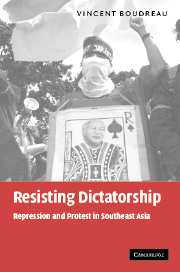Book contents
- Frontmatter
- Contents
- List of maps
- Acknowledgments
- List of abbreviations
- 1 Introduction
- 2 Protest, repression and transition in Southeast Asia
- 3 Authoritarian attack and dictatorial rise
- 4 Protest in socialist Burma
- 5 New Order repression and the Indonesian opposition
- 6 The Philippine new society and state repression
- 7 Repression and protest in comparative perspective
- 8 People power and insurgency in the Philippine transition
- 9 Protest and the underground in Burma
- 10 Indonesia's democracy protests
- 11 Democracy protest and state repression
- List of references
- Index
2 - Protest, repression and transition in Southeast Asia
Published online by Cambridge University Press: 15 December 2009
- Frontmatter
- Contents
- List of maps
- Acknowledgments
- List of abbreviations
- 1 Introduction
- 2 Protest, repression and transition in Southeast Asia
- 3 Authoritarian attack and dictatorial rise
- 4 Protest in socialist Burma
- 5 New Order repression and the Indonesian opposition
- 6 The Philippine new society and state repression
- 7 Repression and protest in comparative perspective
- 8 People power and insurgency in the Philippine transition
- 9 Protest and the underground in Burma
- 10 Indonesia's democracy protests
- 11 Democracy protest and state repression
- List of references
- Index
Summary
Ideas about social conflict underwent a curious change over the twentieth century's last decades. At the height of the Cold War, contentious domestic politics seemed always pregnant with broader conflagration. People on both sides of the ideological fence associated social unrest with worldwide subversion (or proletarian victory), falling dominoes (or a triumphant line of march), and the descent into anarchy (or world historical progress). Middle-class American college students in the 1960s joined “the revolution” while US intelligence officers viewed peasants scrambling to subsist as communist operatives. Many then had difficulty recognizing that social movements often pursued limited objectives from autonomous positions rather than as parts of a larger revolutionary process. Decades after Saigon's “fall,” however, we face an almost complete reversal: as theories about social movements gain credibility and explanatory power, the fears and hopes about revolutionary challenges to state power have quietly yielded to broader assumptions that struggle seeks more modulated influence and access within prevailing systems. Increasingly, analysts examine movement radicalization and violence as signs that participants have become frustrated or disappointed in originally more civil programs of struggle, rather than as inherent aspects of the struggle itself. Of course, attachments to either revolutionary or social movement images have important empirical foundations: for decades world communist organizations did often support revolutions, even where these revolutions remained grounded in local conditions, and the Soviet Union's dissolution, combined with a spate of apparent transitions to democracy, encourage more reform-oriented, less revolutionary protest.
- Type
- Chapter
- Information
- Resisting DictatorshipRepression and Protest in Southeast Asia, pp. 17 - 36Publisher: Cambridge University PressPrint publication year: 2004



